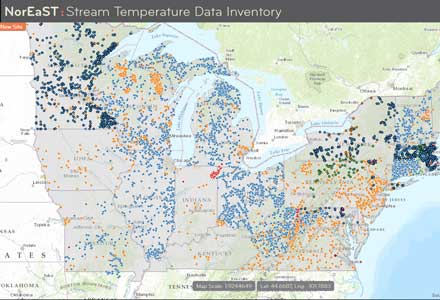Overview & Applicability
Stream data are needed to enable managers to understand baseline conditions, historic trends, and potential impacts of climate change on stream temperature and flow, and in turn on aquatic species in freshwater ecosystems.
NorEaST aggregates steam temperature data from the northeastern and midwestern U.S. into an online map interface linked to temperature datasets. The project is in progress, and currently contains mapped locations and metadata for more than 9000 stream monitoring locations. Many of the stream temperature datasets associated with these points are forthcoming.

The NorEaST online map interface will eventually be linked to thousands of temperature datasets.
History
A number of collaborators from organizations including the USGS ( Great Lakes Science Center, Massachusetts Water Science Center, and the Wisconsin Water Science Center), University of Wisconsin Platteville, Michigan State University, and University of Massachusetts Amherst,. Over 47 organizations contributed data to the effort. Collaborators and their roles are described more thoroughly on the project webpage: https://necsc.umass.edu/projects/noreast-%E2%80%93-stream-temperature-web-portal-demonstration-and-application.
Inputs and outputs
Collaborators are still evaluating data collected by various organizations and stream monitoring systems to build a data template and framework for incoming stream temperature data. Once datasets are uploaded to the web portal, users will be able to access monitoring location data and export stream temperature datasets in several formats including:
- Raw data as csv or html file formats
- Web services for graphing and downloading data using Water ML2 standards (WML2)
Restrictions and limitations
This web portal is still in development and so many planned features, including uploaded stream temperature datasets, are not yet available.
Accessing the web portal and additional information
Tool and project description: https://necsc.umass.edu/projects/noreast---stream-temperature-web-portal-demonstration-and-application
Beta Verison of NorEaST web portal: http://wim.usgs.gov/NorEaST/

